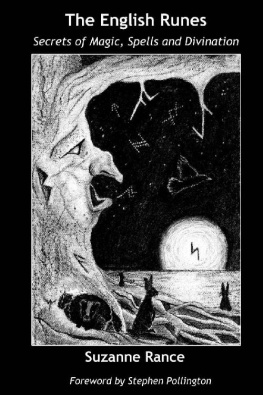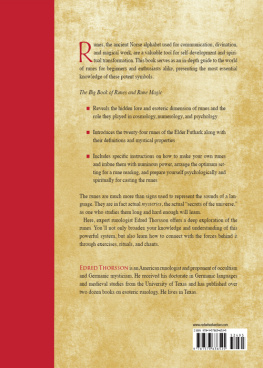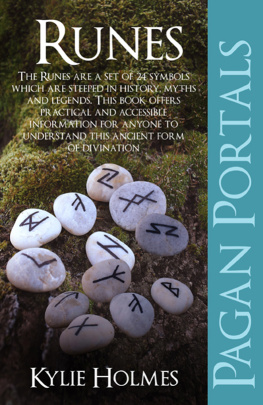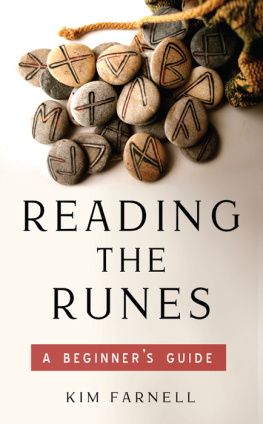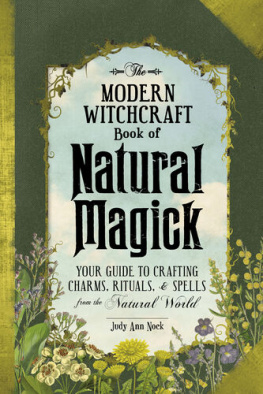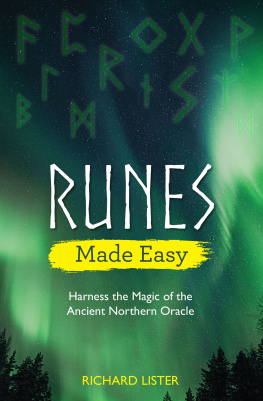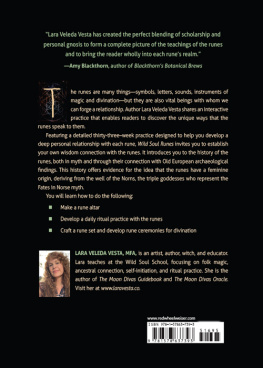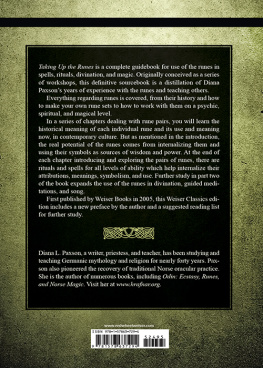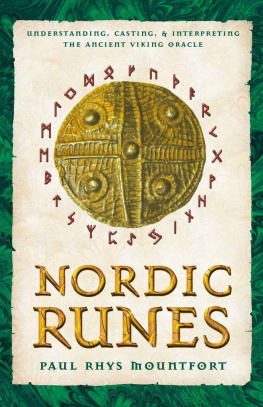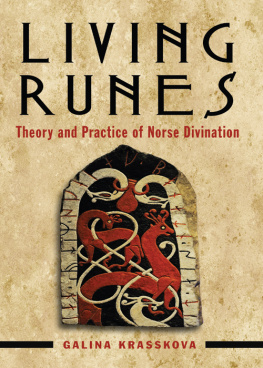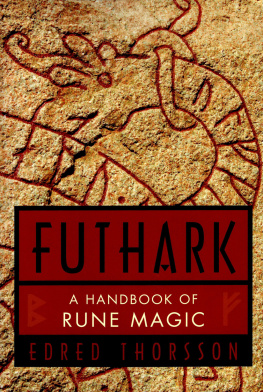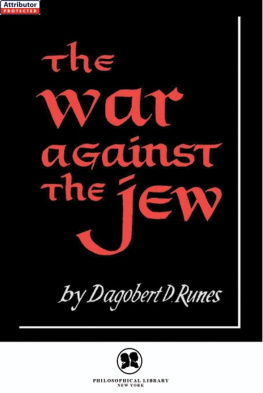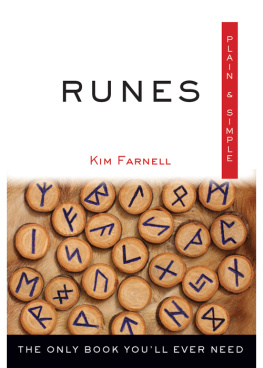The English Runes
Secrets of Magic, Spells and Divination
Suzanne Rance

First Printed 2017

Published by
Dragon House
Copyright 2017 Suzanne Rance
Cover Art 2017 Emma Martin
All rights reserved. No part of this publication may be reproduced, distributed, or transmitted in any form or by any means, including photocopying, recording, or other electronic or mechanical methods, without the prior written permission of the author, except in the case of personal use and certain other non-commercial uses permitted by copyright law. For permission request, email the author at the address below.
This book may not be lent, resold, hired out or otherwise disposed of by way of trade in any form of binding or cover other than that in which it is published, without prior consent.
www.suzannerance.co.uk
ISBN 978 0 9957264 3 7
For
Kevin, Charlotte, Gwynn and Kat
Acknowledgements
I would like to extend my grateful thanks to the following people without whom this book would not exist.
Deborah Westmancoat for kick starting this process with a challenge and for offering to proof read the result. A promise she has kept and undertaken whilst becoming an increasingly successful British Contemporary Artist.
Stephen Pollington for writing the foreword, permission to use his translation of the Old English Rune Poem and for checking my manuscript, Ic oncie .
Emma Martin for her beautiful charcoal artwork that brings my book cover to life. A piece of art created from trees expressing the place of trees and nature in giving life to the English runes.
My copy editor Sarah Nisbet of Inkshed Editorial, whose knowledge of history and common sense approach ensures that I will have no hesitation in asking her again.
I would also like to thank Kevin Poole for his encouragement and support throughout, and Charlotte Rance for her wise counsel on all things pragmatic. Also to Heidi McNie, a big thank you for being there when I came up with new ideas, both good and bad, and for walking the land with me.
Last but by no means least my pagan and heathen friends for your unending encouragement.
Contents
Foreword
In this slender volume, the reader in search of runic knowledge will find much to challenge and entertain. The esoteric and exoteric uses of the runes have been debated in academic and folklore circles for decades - indeed, centuries - so Suzanne Rance wisely offers no one-size-fits-all solutions to the puzzles associated with such knowledge and its transmission.
The strength of Suzanne's book is the emphasis on the Old English Rune Poem (arguably our only source of the rune-names drawn from a near-contemporary document) and one aspect of that work which is easily overlooked by the non-specialist reader. Each verse of the poem is self-contained and offers insight into the nature of the word which is the rune's name. But Old English verse is not a straightforward medium of expression, and multiple meanings are the norm rather than the exception. Ambiguity is indeed the hallmark of early Anglo-Saxon art in every branch - visual as well as verbal - and the subtleties of the language are not easily captured. All credit then to Suzanne for highlighting this often overlooked aspect of the tradition.
Careful study of the runes and working through the text of this book will reward the student who wishes to understand the rudiments of runic tradition.
Steve Pollington
Essex February, 2017
Introduction
You are probably familiar with Runes, an old European lettering system. They can be found widely in literature and film; however, these Runes are usually the Elder Futhark. What people are less aware of is that the English have their own Runes, steeped in the heritage of our ancient land. This book is designed to help you discover the runes found in The Old English Rune Poem and, through this, find out more about the lives of the early English and how they interacted with them. We will briefly look at their history and culture and explore their use in an attempt to breathe life into our ancient past.
I hope to persuade you to find a place in your hearts for the English runes. The British have been known to joke First there were the Romans and then it was dark for ages, but now things are changing. The post-Roman period may once have been known as the Dark Ages but we can step out of this Victorian view; we can discover for ourselves how informed and surprisingly like us the early English people were, but living in a less technologically advanced world.
Over the years the study of runes has been split between those who are only interested in the academic, literary and historical aspects and those interested only in the esoteric aspect. This book attempts to close the gap a little by taking meaning and inspiration directly from the academic and applying it to the esoteric; trying to step in the shoes of the early English. Stephen Pollington is a historian and expert in Old English language and culture and his modern English translation has been used for each rune verse in this book unless otherwise stated.
How to use this book
This book is designed to be both an interesting read and a personal journey for those who wish to learn about runes, primarily the English runes. It is about runic magic and magical experience containing practical exercises to deepen your connection. Wyrd, an early English word for the concept of connection with all of life, is especially important in this journey. There are many suggestions on experiential ways you can use to connect to the people who first used the English runes.
My hope is that through the thoughts and explorations you find in this book you will gain your own personal connection to these runes. Every so often I will be asking you to make notes so I suggest you find a note book or journal to record your thoughts and experiences; however disconnected they may seem at the time. This journal will become an invaluable resource on your journey to find your own personal connection with each individual rune and the magic that surrounds them. There is a companion journal The English Runes: Study Journal available for this purpose as well as a personal divination journal The English Runes: Rune of the Day Journal .
Suzanne Rance
Sussex, England
Spring 2017
Part 1
Runes and
The English Runes
Runes and their history
The runes are a form of alphabet: each rune has both an individual sound and a specific name. It is said that knowing the name of something/someone gives you power over it/them; a concept that occurs in historical cultures from ancient Egypt and the Americas, and can be found in the Bible and the folklore of many lands. No one is certain why each rune has an independent name and meaning, so, although all writing in the ancient world held power, the naming of runes seems to enhance their power above all other alphabets used in European society.
Runes as we understand them today are believed to have been formed during the period c. bce to 150 ce; however, potential earlier instances can be dated back as far as 1300 bce . Ancient rock markings with visible similarities to runes can be found across the Eurasian continent and were carved using straight lines, but archaeologists are yet to find conclusive proof that these are early runes.

